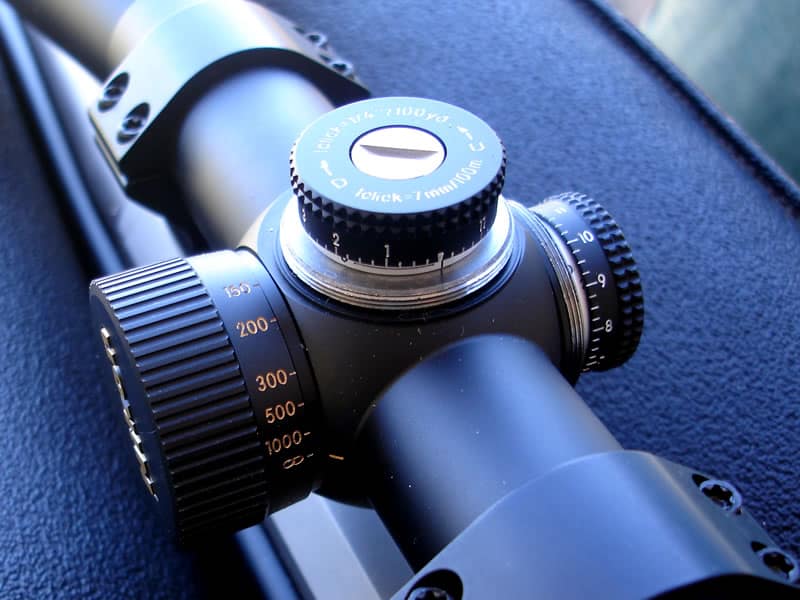One of the biggest questions about scopes is about the AO feature, which can greatly impact the price and capabilities of the scope. What does AO mean?
AO stands for adjustable objective, but unlike what you may believe, it has nothing to do with the image focus and doesn’t only focus the reticle. It has to do with focusing the reticle to the target objective in alignment with your eye. In other words, it is a parallax adjustment.
It allows the reticle, which has been focused to your eye, to be adjusted to the same viewing plane as the target image.

Parallax
Parallax is the effect that occurs when an object is viewed through a lens and the object appears to move or be in a different position when you view it at different angles.
A good example of this is if you view an item about twenty feet away, hold your thumb out in front of you and cover up the item image. Then move your head around. You will find that the item is no longer covered up by your thumb, even though your thumb hasn’t moved.
This is parallax. Your aiming point is still on target, but it doesn’t appear to be, so you will re-adjust according to this and throw off your shot. This happens because your aiming point is adjusted in relation to your eye but is not on the same objective plain as the target.
Now, stay in the same position, but have a friend place their thumb on the item you are viewing. Now if you move your head in different positions the aiming point (the thumb) is still covering the target because it is on the same objective plain. This is essentially how parallax adjustments work.
Types Of Parallax Adjustments
Non-AO scopes have a set or fixed parallax at about 150 or 200-yards. This distance is okay for some hunters and definitely for plinking, but beyond this distance, your reticle will float a little bit if your scope if fixed.
For further distance and precision shooting, you definitely want to be able to adjust your parallax. There are two main types of parallax adjustments. These would be the adjustable objective, which is where the term AO comes from, and side knob adjustment. Sometimes, you can also find a hybridized combination of both.
Having the option to adjust your parallax at whatever distance up to infinity does affect the price of your scope, but of the two adjustment types, generally, AO types are a bit on the more affordable side. This is because they are simpler and easier to make.
The adjustment is built sleekly into the end of the objective bell and rotates to the left or right to adjust. Because of this design, they also make for a lighter scope with a smaller profile.
The downside of this style of adjustment is that you have to reach way forward and adjust your positioning in order to make your adjustments, so it’s a better idea with this style to set your adjustments before your shooting activity.
The side adjustment knob is set in the center of the scope with the windage and elevation knobs. This type is the easiest to adjust and is better for tactical situations as you can simply make your adjustments while in a prone position and while looking through your scope.
It can be adjusted as needed. The downside of this type is that it is heavier and a bit bulkier than the AO adjustable style. These are also generally the more expensive of the two options.
Purpose Of AO
In a nutshell, the purpose of AO is for precision. If you are just out doing some target shooting or like to do shooting sports or hunting within a range that can be met by a fixed parallax scope, this would be the cheaper and simplest option.
However, if you are a tactical shooter like a sniper, or like to do long-range hunting or range competitions, then you would probably want to go ahead and purchase an AO scope with a good parallax adjustment.
Cutting back on that parallax effect is absolutely crucial when trying to achieve those long-range one-shot bulls-eye shots. We’ve written more on the best long range rifle scopes for the money if you want to read more on them.
Personally, I like having the side adjustment knob over the adjustable objective simply for the ease of use, but they are usually more expensive, so for budget purposes, the adjustable objective would be a good decision. Both serve the same purpose of eliminating the parallax effect.
Although it is not really considered a purpose of AO, having parallax adjustment capabilities also innately turns your scope into a range-finding scope.
The adjustment has yardage numbers on it so you can set and remember approximately where you need to adjust for parallax at certain distances. It’s a bit more complicated with the infinity setting, but if you are looking through your scope at a target and do not know how far out it is, adjust the parallax until it’s gone and clear, then you can approximate your distance based on the parallax yardage setting.
Pros
- both reduce or eliminate parallax
- some are capable of adjustments out to infinity
- parallax adjustments effectively turn your scope into a range-finding scope
- AO adjustments are cheaper, lighter, and lower profile than their side knob adjustment counterparts
- side knob adjustments are much easier to use while on target
Cons
- parallax adjustment scopes are overall more expensive
- side knob adjustable scopes are more expensive than AO scopes, as well as being heavier and bulkier
- adjustable objective scopes require a farther reach to adjust, so you have to move more and potentially get off target, or preset your adjustments for a certain distance before-hand
Conclusion
You should now have a pretty good grasp on what AO means for scopes, and if this is a feature that is necessary for your shooting needs or if you can live with a fixed parallax setting.
Either way, you’re bound to notice that parallax at some point so get out and practice focusing in that reticle so you can achieve the perfect shot every time.
If you enjoyed this article you’ll probably like these:


